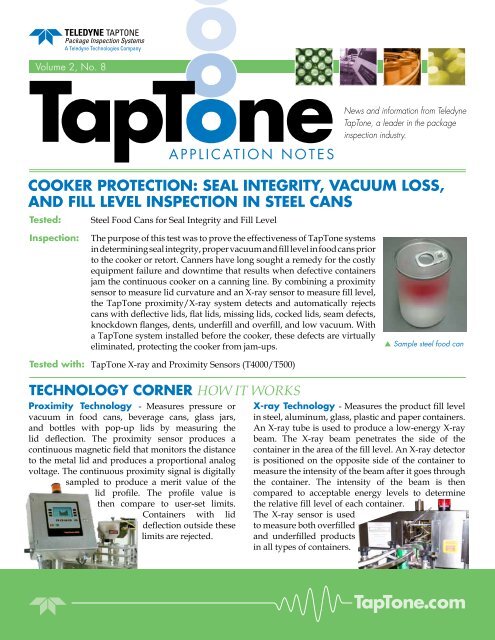You also want an ePaper? Increase the reach of your titles
YUMPU automatically turns print PDFs into web optimized ePapers that Google loves.
Volume 2, no. 8<br />
<strong>TapTone</strong><br />
ApplicAtion notes<br />
Tested: Steel Food Cans for Seal Integrity and Fill Level<br />
Inspection:<br />
The purpose of this test was to prove the effectiveness of <strong>TapTone</strong> systems<br />
in determining seal integrity, proper vacuum and fill level in food cans prior<br />
to the cooker or retort. Canners have long sought a remedy for the costly<br />
equipment failure and downtime that results when defective containers<br />
jam the continuous cooker on a canning line. By <strong>com</strong>bining a proximity<br />
sensor to measure lid curvature and an X-ray sensor to measure fill level,<br />
the <strong>TapTone</strong> proximity/X-ray system detects and automatically rejects<br />
cans with deflective lids, flat lids, missing lids, cocked lids, seam defects,<br />
knockdown flanges, dents, underfill and overfill, and low vacuum. With<br />
a <strong>TapTone</strong> system installed before the cooker, these defects are virtually<br />
eliminated, protecting the cooker from jam-ups.<br />
Tested with: <strong>TapTone</strong> X-ray and Proximity Sensors (T4000/T500)<br />
News and information from Teledyne<br />
<strong>TapTone</strong>, a leader in the package<br />
inspection industry.<br />
COOKER PROTECTION: SEAL INTEGRITY, VACUUM LOSS,<br />
AND FILL LEVEL INSPECTION IN STEEL CANS<br />
TECHNOLOGY CORNER How it works<br />
Proximity Technology - Measures pressure or<br />
vacuum in food cans, beverage cans, glass jars,<br />
and bottles with pop-up lids by measuring the<br />
lid deflection. The proximity sensor produces a<br />
continuous magnetic field that monitors the distance<br />
to the metal lid and produces a proportional analog<br />
voltage. The continuous proximity signal is digitally<br />
sampled to produce a merit value of the<br />
lid profile. The profile value is<br />
then <strong>com</strong>pare to user-set limits.<br />
Containers with lid<br />
deflection outside these<br />
limits are rejected.<br />
p Sample steel food can<br />
X-ray Technology - Measures the product fill level<br />
in steel, aluminum, glass, plastic and paper containers.<br />
An X-ray tube is used to produce a low-energy X-ray<br />
beam. The X-ray beam penetrates the side of the<br />
container in the area of the fill level. An X-ray detector<br />
is positioned on the opposite side of the container to<br />
measure the intensity of the beam after it goes through<br />
the container. The intensity of the beam is then<br />
<strong>com</strong>pared to acceptable energy levels to determine<br />
the relative fill level of each container.<br />
The X-ray sensor is used<br />
to measure both overfilled<br />
and underfilled products<br />
in all types of containers.<br />
<strong>TapTone</strong>.<strong>com</strong>
ApplicAtion notes<br />
SEAL INTEGRITY TEST<br />
Vacuum, if present in the can prior to reaching the cooker, is detected<br />
using proximity inspection. The proximity sensor measures the deflection<br />
of the can end caused by the vacuum in the can. The average merit value<br />
for the good, non leaking cans was 350. Leaking cans had an average merit<br />
value of 175.<br />
The proximity sensor is capable of detecting a lid deflection of .003” - .014”<br />
(.076mm - .355mm) under production line conditions. The system inspects<br />
100% of the cans on the line and will reject all cans that have lid deflections<br />
outside limits established by the user.<br />
BUCKLED CAN / DAMAGED CAN END TEST<br />
Proximity inspection is used to identify missing or damaged can ends and<br />
buckled cans in applications where no vacuum or very limited vacuum<br />
has been created prior to the cooker. The proximity sensor will take up<br />
to 256 readings across the top of each can creating a profile of the can<br />
end. A buckled can or a can with a damaged or missing end will have a<br />
significantly different profile from that of a good sealed can. Cans with<br />
profiles outside of user set acceptable limits can be removed from the<br />
production line before they ever reach the cooker.<br />
X-RAY UNDERFILL/OVERFILL TEST<br />
Cans with varying fill levels were tested using the <strong>TapTone</strong> X-ray sensor.<br />
The target fill level was determined by the gross weight of the can.<br />
Samples were tested multiple times to develop an average merit value<br />
for the specific fill level. In this test, the target weight of 400 grams was<br />
determined to be a properly filled can.<br />
Overfills - Cans with a weight of 410 grams or higher were determined to<br />
be over filled. These cans would not cook evenly in the cooker due to the<br />
lack of head space.<br />
Underfills - Cans with a target weight of 390 or less were considered<br />
underfilled. The excess head space in these cans could expand when<br />
heated in the cooker. This would cause excessive internal pressure and<br />
could cause the can end to burst inside the cooker. The graph shows the<br />
<strong>TapTone</strong> X-ray system is capable of detecting cans that are overfilled as<br />
well as cans that are underfilled.<br />
<strong>ooooooooooooooooo</strong><br />
low vacuum<br />
cans<br />
Good cans<br />
with vacuum<br />
pg 2<br />
<strong>TapTone</strong>.<strong>com</strong>
ApplicAtion notes<br />
<strong>ooooooooooooooooo</strong><br />
SUMMARY - The <strong>TapTone</strong> proximity sensor can detect leaking cans, dented/buckled cans, missing and damaged<br />
can ends. The X-ray sensor will detect underfilled and overfilled cans. These defects are the most <strong>com</strong>mon causes<br />
of cooker jams. When placed after the seamer and prior to the cooker, the <strong>TapTone</strong> Proximity/X-ray system will<br />
detect these defective cans and remove them from production, eliminating the potential of a cooker jam.<br />
49 edgerton Drive • north Falmouth, MA 02556 UsA<br />
p: +1 508.563.1000 F: +1 508.564.9945 e-Mail: taptone@teledyne.<strong>com</strong><br />
1/20/12. Specifications subject to change without notice.<br />
<strong>TapTone</strong> is a registered trademark of Teledyne <strong>TapTone</strong>. Copyright 2012, Teledyne <strong>TapTone</strong>.<br />
pg 3<br />
<strong>TapTone</strong>.<strong>com</strong>



